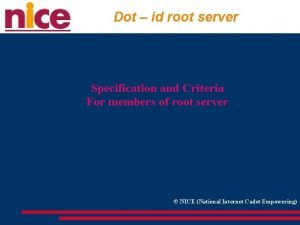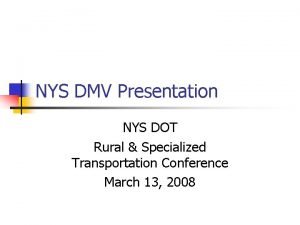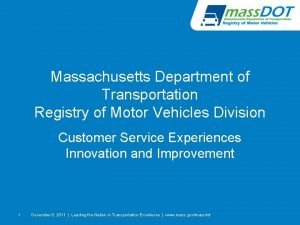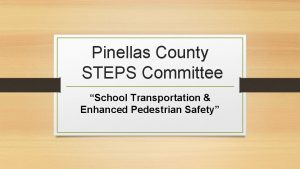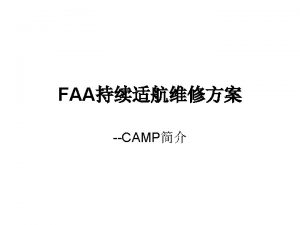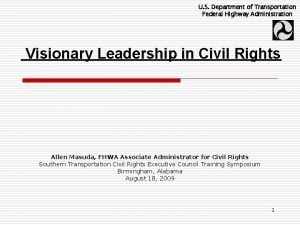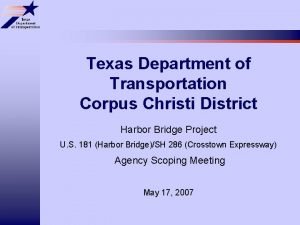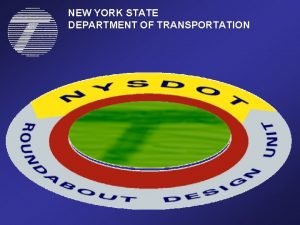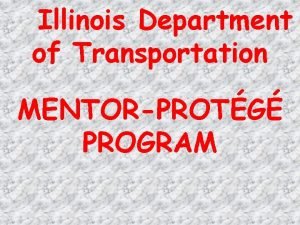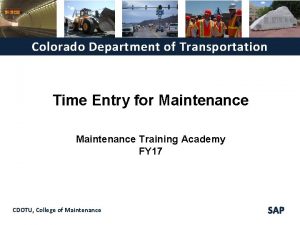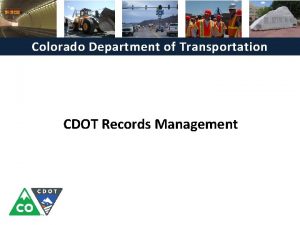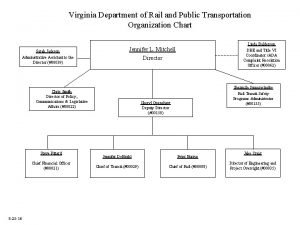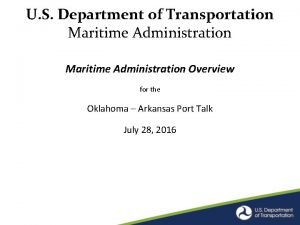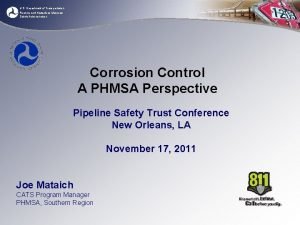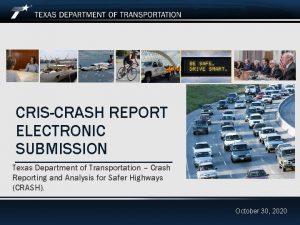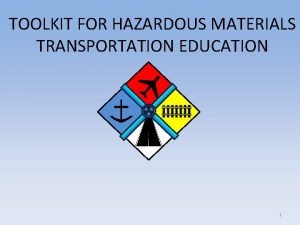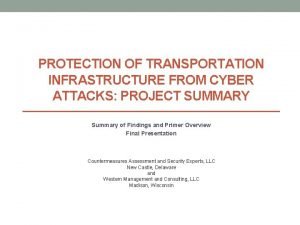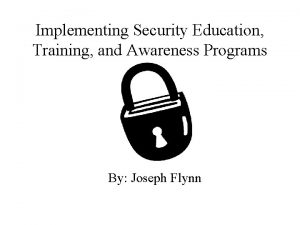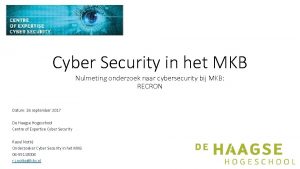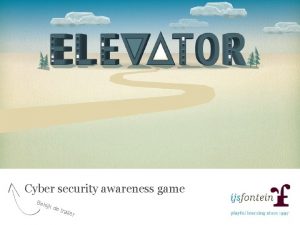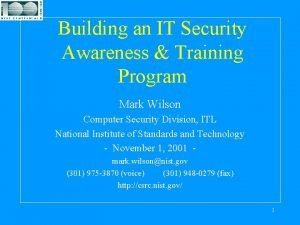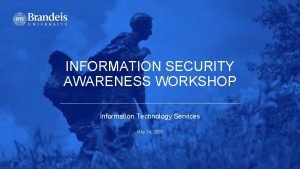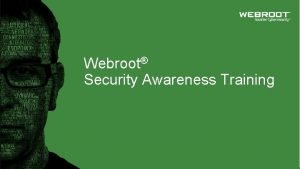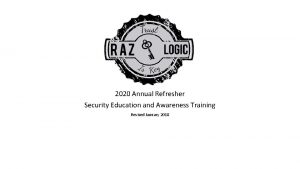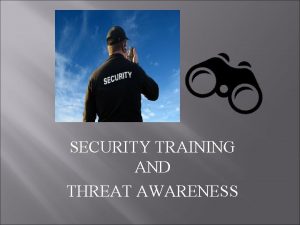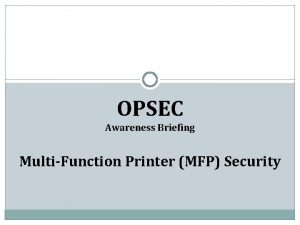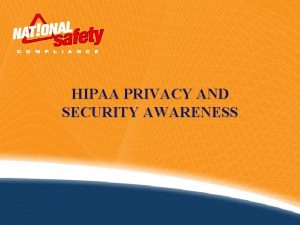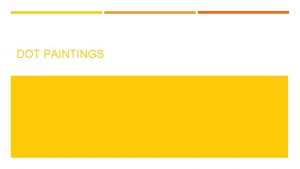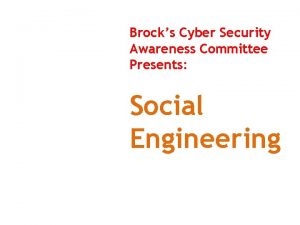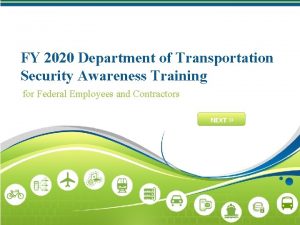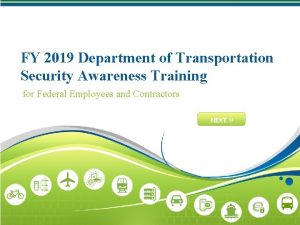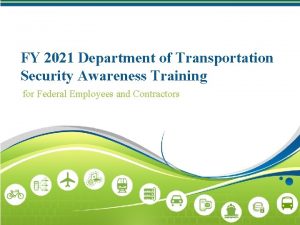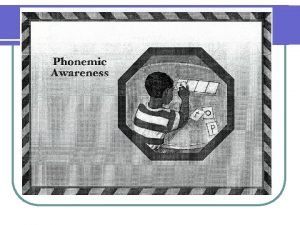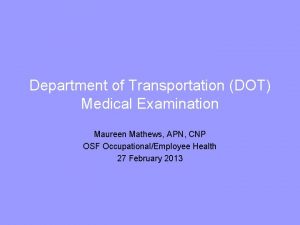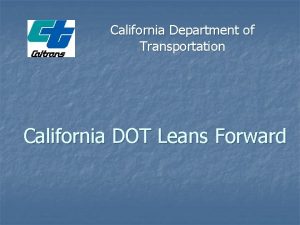FY 2018 Department of Transportation DOT Security Awareness









































- Slides: 41

FY 2018 Department of Transportation (DOT) Security Awareness and Privacy Training part 1 for Federal Employees and Contractors Next

FY 2018 Department of Transportation (DOT) Security Awareness Training (SAT) for Federal Employees and Contractors Next

Overview You are the Department of Transportation’s (DOT) best defense against those who seek to disrupt the Agency’s transportation systems and business processes, and negatively affect the security posture of the United States. As a DOT federal employee or contractor, you must: • Be familiar with DOT Information Systems Security (ISS) policies, procedures, and best practices, • Understand the risks associated with your activities while accessing DOT systems and information, and • Understand your responsibilities and obligations for protecting DOT data, information, and information system assets. Back Next 3

Goal of Training This security awareness course will: • Focus your attention on the most pertinent DOT policies, procedures, and best practices as they relate to information security. • • Highlight the risks associated with accessing DOT systems and information, and Identify your responsibilities for protecting DOT systems and information from unauthorized access and disclosure. Back Next 4

Why this Training is Required You must take this training because: You are a DOT federal employee, contractor, subcontractor, intern, on detail with the DOT, or temporary worker (from now on referred to as DOT workforce), You have access to DOT systems and information, You have an obligation and responsibility to protect DOT information and systems from unauthorized access or disclosure, and SAT is required by federal law and DOT policy. Back Next 5

Policy References and Requirements Which federal laws and DOT policies identify the Security Awareness Training requirement? • Federal Requirements: – Federal Information Security Modernization Act (FISMA) of 2014 – OMB Circular A-130, Appendix III, paragraph 3 (2)(a) – OMB M-07 -16 - Safeguarding Against and Responding to the Breach of Personally Identifiable Information • DOT Policy – DOT Order 1351. 37 Departmental Cybersecurity Policy – Departmental Cybersecurity Compendium Version 4 Back Next 6

Acknowledgments What is Expected of Me? • Before gaining access to DOT information systems (or within 30 days of onboarding), all DOT users must: – Read and agree to the DOT Rules of Behavior – Complete the annual Security Awareness Training • Certain members of the DOT workforce that have elevated ISS responsibilities may be required to complete additional specialized training for their assigned role. • You must complete these items annually thereafter. Back Next 7

DOT Rules of Behavior What are the DOT Rules of Behavior? The DOT Rules of Behavior is a notice to all department workforce personnel defining how you may use DOT information and information systems. • Do the Rules of Behavior apply to you? – The rules apply to any individual in the DOT workforce who accesses, stores, receives, or transmits DOT information using Information Technology (IT) resources at their primary or alternate worksite (for example, home office). – These rules do not apply to members of the public accessing publically available DOT information or information systems. – These rules do not apply to individuals that are able to access DOT information that is not publically available, but do not use the information at their primary or alternate worksite (e. g. State DOT employees) NOTE: If you do not agree with the DOT Rules of Behavior, the DOT will not allow you to access its network or systems. Back Next 8

Protecting DOT Data and Information Why Protect DOT Data and Information? • A lot of the information and data you use at work is essential to the DOT and its Modes to maintain a safe and efficient transportation system. • Your access to DOT information is important for you to perform your job. • Some information you use requires stronger protection and enhanced handling procedures to ensure that it is not misused or accessed by unauthorized individuals. Back Next 9

Accessing DOT Systems and Resources What are DOT IT Systems and Resources? – Workstations, laptop computers, servers. – The network infrastructure (for example, wiring and cable, routers, switches, printers, etc. ). – Personal digital assistants and tablet computers (for example, Palm Pilot, i. Pad, etc. ). – Cellular, mobile, smart phones, text messaging systems (for example, Black. Berry Messenger and i. Phone). – Plug-in and wireless add-ons that employ removable media (for example, USB flash memory (thumb) drives, external drives, diskettes, CDs, DVDs, etc. ). – DOT Information, data, reports, websites, etc. Back Next 10

Accessing DOT Systems and Resources Accessing DOT Systems • The DOT provides you access to its network and systems to conduct official business on behalf of the DOT. – You are responsible for the security of your account, password, and the information and data you access with your account. – Users of DOT systems have no reasonable expectation of privacy when using a DOT information system – To protect the DOT network and systems from misuse or unauthorized access, the DOT reserves the right to monitor the DOT network and all attached systems, including all activity on your system. • You must agree to abide by the DOT Rules of Behavior. Back Next 11

Accessing DOT Systems and Resources Access to DOT Systems • You must complete annual training: – Mandatory completion of Security Awareness Training (SAT) (this course). – System-specific training (as required). – Specialized information security rolebased (if applicable to your job duties). • Refer to Appendix D of the DOT cybersecurity Compendium for more information on which roles require specialized training. NOTE: If you do not agree with the DOT Rules of Behavior or the Monitoring of your activities, you must not use the DOT network or nay DOT system. Back Next 12

Accessing DOT Systems and Resources Types of Information Used at DOT • Use of DOT information and data is essential to the DOT and its Modes to maintain a safe and efficient transportation system. DOT resources are the devices, hardware, and information needed to get the job done. DOT resources include: Workstations, laptop computers, servers The network infrastructure (e. g. , wiring and cable, routers, switches, printers, etc. ) Tablet computers (e. g. , Android Tablet, i. Pad, etc. ) Smart Phone, text messaging systems (e. g. , Android and i. Phone) Plug-in and wireless add-ons that employ removable media (e. g. , USB flash memory aka thumb drives, external drives, diskettes, CDs, DVDs, etc. ) • DOT information, data, reports, websites, etc. • • • Back Next 13

DOT Internet and Email summary Limited Personal Use The primary function of the DOT Internet and email systems is for business use only. Your limited personal use of the Internet and email system must not: • Compromise the security of DOT information and information systems, • Interfere with the DOT’s normal business operations, or • Keep any DOT employee or contractor from performing their assigned DOT duties. Certain activities are strictly prohibited from access to or use on DOT systems and may result in termination from the DOT, and/or other disciplinary actions. Examples include, but are not limited to: • Accessing pornographic material • Gambling • Operating a private business Warning: Your use of the DOT Internet and all e-mail received, stored, or transmitted is monitored and may be intercepted by DOT for any lawful purpose, including ensuring compliance and detection of cyber threats, including your username(s), account logon ID, password(s), credit card number(s), and other, potentially personal, information. Back Next 14

DOT Internet and Email detail Appropriate Use of DOT Internet or Email • You may use the DOT Internet or Email for valid work requirements, including but not limited to: – Exchange of information that supports the DOT mission, goals, and objectives. – Job related professional development for DOT workforce personnel. – Access to scientific, technical, and other information that has relevance to the DOT. – Business-related communications with colleagues in Government agencies, academia, and industry. Inappropriate Use of DOT Internet or Email • You may not use the DOT Internet or Email to: – Stream audio or video (unless work related). – Download or share files from peer-to-peer networks. – Attempt unauthorized access to information systems. – Host any type of internet server or connect to personal devices – Auto-forward DOT e-mail to a personal account. – Respond to, send, CC, or forward jokes, chain emails, or offensive content. – Send DOT information to your personal accounts Back Next 15

Social Media There are very limited times you may use social media for personal reasons at work. • • • The DOT has established a Social Media Policy (“Web-based interactive Technologies Policy”) for employees to follow when using social media platforms (Facebook, Twitter, Myspace, You. Tube, etc. ) All DOT workforce personnel must follow the DOT Social Media Policy and adhere to the Standards of Ethical Conduct for Employees of the Executive Branch, 5 CFR, Part 2635, whether their social media activities are work related for official business or personal in nature. Use of social media/networking sites, blogs, and instant messaging is outlined in DOT Order 1351. 33, Appendix A Employee Conduct Policy. • Using social media at work must be part of your job function or for professional development purposes Employees should be mindful that excessive and/or inappropriate personal use of social media during work hours may result in disciplinary action, up to and including removal from federal service. Back Next 16

Social Media continued • Mentioning DOT in an Official Capacity – Employees are not authorized to act as official Government representatives without permission from the Office of Communications. • Mentioning DOT in Personal Remarks – Your Use of social media is subject to First Amendment protections. However, if your personal views on a subject may be attributed to DOT’s official position, include a disclaimer that says: “The views expressed here are my own and not necessarily those of DOT. ” – Employees with public-facing roles and responsibilities must consider whether personal thoughts published online, even in personal venues, may be misconstrued as expressing DOT policy. Back Next 17

Care and Use of GFE Use of Government Furnished Equipment (GFE) By using your DOT furnished equipment, you must: • Never make unauthorized changes to your GFE or attempt to circumvent the implemented security measures • Agree to the monitoring of your activities • Not install unauthorized software • Not allow other users to use your logon ID and password to access DOT systems • Comply with all software copyrights and license agreements • Never view or download pornographic or offensive content NOTE: Do not make unauthorized changes to your government furnished equipment or attempt to circumvent the implemented security measures. Back Next 18

Care and Use of PED Portable Electronic Devices (PED) Use Requirements – You must only use GFEs and PEDs to access DOT systems. • All industry and/or personal devices must be explicitly approved and authorized before use to access DOT systems. – Ensure anti-virus and firewall software is installed and up-to-date. – Never connect your laptop to a DOT network and a non-DOT network at the same time. – Use DOT-approved encryption software for storing and transmitting. all PII and DOT-sensitive information. – Only use DOT approved Bluetooth and wireless communication devices with your DOT equipment. – Be aware of the dangers associated with mobile “hot spots” and use secure connections when possible. – Install DOT-approved full hard disk encryption. Back Next 19

Travel with GFEs and PEDs • When traveling with DOT provided laptops and mobile devices, you must: – Take precautions to prevent theft, damage, abuse, or unauthorized use. – Keep equipment under physical control at all times. • What does “physical control” mean? ‒ Maintain sight of equipment to the best of your physical ability when going through airport security. ‒ Never place DOT equipment in checked luggage. ‒ Never store DOT equipment in public lockers. ‒ If you must leave DOT equipment unattended, you must physically secure it in the highest reasonable manner for the environment. (for example, lock it out of sight in a vehicle trunk, lock it in a hotel room or safe, etc. ) ‒ Follow the DOT ROB when taking a DOT-issued laptop or mobile device on foreign (non-US) travel. Back Next 20

PIV Card Your Personal Identity Verification (PIV) Card • Your PIV Card is more than a picture ID. It contains sensitive information about you and your system access rights. – Never leave a PIV card unattended on a desk or in a workstation. • Protecting passwords and PIV Cards is a first-line defense against internal cyber threats. – Never share your PIV card or Personal Identification Number (PIN). • If your PIV Card is lost or stolen, you must report the loss immediately to your supervisor and to your security servicing organization. Back Next 21

Passwords and Access Control Measures • • Each user must have his or her own unique logon account. Passwords must: – Be at least twelve (12)* characters long and have a combination of letters (upper- and lower-case), numbers and special characters, and – Be updated at least every 60 days, or immediately if you suspect your password has been compromised. • Always protect passwords, PINS, and access numbers. – Never share a password with anyone, including system administrators. – Do not write passwords down or store them in an electronic file on workstations, laptops, or personal technology, unless the file is encrypted. – Make sure no one is watching when you enter your password or PIN * Some systems have an approved waiver for passwords with fewer than 12 characters. Back Next 22

Identity Monitoring and Restoration Services Preparing against Identity Theft • Several years ago the agency put in place free credit monitoring and protection services to allow DOT employees to be prepared should they become a victim of identity theft. Included in Coverage: • • Daily identity monitoring services. Identity theft insurance. Access to personalized assistance from a Fraud Resolution Agent. Credit card monitoring. Additional Information: • • Contact the Identity Force call center on 1 -877 -MYIDFORCE (877 -694 -3367) Monday through Friday between 8: 00 a. m. to 8: 00 p. m. Eastern Time for questions about your existing Identity Force account. If you have questions about this coverage, please contact the DOT Chief Privacy Office at privacy@DOT. gov. Back Next 23

What is PII? Any information about a human being, living or deceased, regardless of nationality, that is maintained by a federal agency and permits identification of that individual to be reasonably inferred by either direct or indirect means. PII includes, but is not limited to: – – – – Name Social Security Number Date and place of birth Mother’s maiden name Biometric records Medical records Educational records – – – – Financial information Employment information Driver's license Criminal history and investigation Leave balance used Drug testing results National origin Back Next 24

SBU and SUI • Sensitive but Unclassified (SBU), Sensitive Unclassified Information (SUI) – Information and data that is necessary to operate DOT systems. Because of the sensitive nature of the information you must place a degree of control over its use and dissemination. – Examples of SBU/SUI data include, but are not limited to: • IP addresses of DOT systems • Account logon information • Passwords • System vulnerability information • Business records • Operating procedures • Security plans • Other information that the DOT deems sensitive Back Next 25

Classified Information • Classified Information – Classified information is material that a government body has determined is sensitive and requires protection of confidentiality, integrity, or availability. – Access is restricted by law or regulation to particular groups of people. – A formal security clearance is required to handle classified documents or access classified data. Mishandling of classified material can incur criminal penalties.

Data Breach and Identity Theft What is a Data Breach? A data breach is the loss of control, or unauthorized access to personally identifiable information, whether physical or electronic. A data breach can occur through data mining, which is when technology is used to discover information in massive databases, uncover hidden patterns, find subtle relationships in existing data, and predict future results. – According to the 2015 Ponemon Institute Global Data Breach Study, the cost of a data breach is $214 per record – The average total per-breach cost in 2015 was $3. 79 million. What is Identity Theft? When someone uses your PII such as your name, SSN, or credit card number, without your permission, to commit fraud or crimes. Identity theft is a felony under the Identity Theft and Assumption Deterrence Act of 1998. Back Next 27

Protecting Sensitive Data and Information As a user of DOT information systems, it is your responsibility to protect PII, SBU, SUI, and other DOT sensitive data by: • Ensuring DOT information and records are properly (stored, handled, disposed) in accordance with DOT policy. • Not disclosing DOT information (in any form), unless – Only when authorized, – On a “need to know” basis, or – Required by federal law obligations such as the Freedom of Information Act. • Not providing DOT information obtained through government employment to another person or organization, which is not otherwise available to the public. • Not using information obtained through government employment which is not otherwise available to the public. Warning: You must NOT access, process, or store classified information on any device that has not been authorized for such processing! Back Next 28

Protecting Sensitive Data and Information continued How Do I Protect DOT Sensitive Data and Information? All DOT workforce personnel must: • Utilize DOT-approved encryption software when transmitting or storing PII or sensitive data. • Only access PII and other sensitive data for which you are authorized. • Only use DOT approved devices for storing and processing PII and other sensitive data. • Obtain proper approval before responding to external agency request for PII or sensitive information. • Lock workstations and laptops while away, even for a short time. (for example, going to the bathroom, retrieving items from the printer, etc. ). • Protect all PII and sensitive data as if it were your own. Back Next 29

Remote Access Teleworking • The DOT permits certain workforce personnel to complete job responsibilities from a location other than their normal workplace. • Before you telework, you must: – Be designated as a telework employee. – Familiarize yourself with and adhere to the DOT Order 1501. 1 A Telework Policy. – Have an approved telework agreement in place. – Have an agreed upon work schedule with your manager. – Contact your manager or visit the DOT telework website for additional information on teleworking and to see if you are eligible. Back Next 30

Remote Access continued Teleworking Continued • While you are teleworking, you must: – Follow security practices that are the same as or equivalent to those required at your primary workplace. – Adhere to all provisions of your telework agreement. – Protect PII and sensitive data at your alternate workplace by: • Only using GFEs to download and/or store PII and other DOT data. • Use DOT-approved encryption software when transmitting or storing PII or DOT sensitive data. • Properly dispose of sensitive information. Back Next 31

Remote Access continued Bring Your Own Device (BYOD) Users may only access DOT information systems and networks using DOT-provided or approved personally-owned technology (for example, personal computer, laptop, printer, smart phone, tablet, etc. ). • When using personally-owned technology on a DOT network, you must: – Complete and sign the appropriate technology agreement(s). – Allow authorized personnel to monitor and examine your technology upon request. – Use DOT-approved security and encryption software for storing or sending DOTsensitive information or PII. – Allow the installation and use of strong authentication (for example, PIV card). – Agree to allow the DOT to wipe the technology if it is lost or stolen. – Understand that a security incident involving your personally-owned technology may result in: • the seizure of your personally-owned technology, • the loss of software you may have purchased, and • the loss of all personal data on the technology. Back Next 32

Remote Access continued Your Home Computer and Personal Data Protecting your systems and data at home is just as critical as it is at work. Here are some tips to protect your home computers and your data. • Keep your home devices up-to-date – Install a good anti-virus software on every computer in your home and keep it up-to-date. – Be cautious of installing free and shareware software – they may contain malicious code. – Install security updates to installed software immediately. – Make sure the software updates are from the software vendor. – Enable the automatic update feature of your software. • Email – Do not open emails and attachments from people that you do not know. – Do not click on links in emails from people that you do not know. – Never respond to requests to provide your personal information or account numbers. – Delete suspect emails so that you do not click on them in the future. Back Next 33

Remote Access Your Home Computer and Personal Data (continued) Here are some tips to protect your home computer and your data. • Internet use – Use caution when surfing or searching the web. – Use caution when ordering merchandise or services over the Internet. – Make sure that the website uses a secure mode (HTTPS) before you enter your password, credit card number, other personal information. – Be wary of transfers from the website you visited. • Social Media – Never post work related information on your personal social media sites. – Restrict your interactions on social media sites to people you know. – Remove geocaching data from your photos before you post them. Back Next 34

Remote Access (continued) Your Home Computer and Personal Data (continued) • Kids and Safe Computer use – Never allow your children, spouse, or others to use your DOT computer, laptop, smart phone, or other DOT equipment to play games or access the Internet. – Monitor your kids activity while they are on-line. – Restrict their website access to age-appropriate content that you review and approve. – Know who your kids are communicating with via email, chat, and other social media sites. – Watch for signs of cyber bullying. – Teach your kids not to place personal information such as home address, age, gender, school information, etc. on websites, social media sites, or in emails. – Don’t let your kids download software, files, music, videos, etc. without your permission. • You can find more resources for keeping your kids safe online at http: //www. safekids. org/. Back Next 35

Cyber Incidents Know Your Responsibilities In order to avoid cyber incidents that could compromise DOT systems and information, you must: • Know your responsibilities for protecting DOT systems and data. • Understand the risks associated with the actions you take while using DOT systems or accessing DOT information and data. • Know how to handle and protect the equipment that DOT provides to you for your assigned job. • Know what you are permitted and NOT permitted to do while using the DOT equipment. • Understand your responsibilities when teleworking. • Understand your responsibilities while traveling on official DOT business. Back Next 36

Cyber Incidents Understanding the Risks Hackers • Hackers are always trying to break in to Government systems for various reasons. – – For bragging rights, for fun, or just to prove that they can. To disrupt normal service. To gain valuable information on projects for unfair competitive gain. To gain access to your personal data so they can steal your identity. • Hackers use many methods to gain unauthorized access to government systems. They often: – Take advantage of vulnerabilities in software to break in to Government systems. – Use emails to entice you to provide your personal information. – Lure you to click on malicious links on websites. – Call you on the phone and ask for the information they want. – Offer you free software, subscriptions, USB drives, CDs, or DVDs. Back Next 37

Phishing Understanding the Risks Phishing • Phishing is an attempt to convince you to give up your personal information, usually through an email from an authentic looking source (for example, a system administrator, your bank, credit card company, or maybe even from someone you know). – You should delete the email so that you don’t accidently click on it in the future. – Do not respond to the email. – Do not give out your personal information to an unsolicited email request. – Never give out your user name or password. – Do not subscribe to offers of “free” services or subscriptions. • If you believe that you have opened a suspected malicious email, you must report this to the DOT Security Operations Center (SOC) immediately. Spear Phishing – Spear Phishing is a targeted phishing attempt toward a specific person or group of people. – Do not respond to any spear phishing messages. – You should report spear phishing attempts to the FAA CSMC so they can alert others in the affected group Back Next 38

Cyber Incidents Incident and Response Protocol • Malicious web links are links that can download malware to your system and allow a hacker to gain access. • • Social Engineering is a method used by hackers so they may gain information that allows them to access your system. The person usually pretends to be someone in authority such as a system administrator or helpdesk person seeking your help. • • • Do not click on links in emails that you do not know. Be cautious of links on websites of unknown origins – it could download malicious code. If you click on a malicious web link, you must report this incident immediately to the DOT SOC. Never give out your logon ID or password to anyone. Do not respond to surveys from third parties. (non DOT sponsored surveys) Do not provide any information to anyone that does not have a “need to know”. Refer inquiries from potential social engineering proponents to the DOT Public Affairs office Malware is malicious code that may cause harm to your system or data. Malware may also allow unauthorized access to DOT systems. • • Never insert unauthorized media (USB devices, CDs, DVDs, etc. ) into any system. Never install unauthorized software on any DOT system. • Do not download unauthorized files – they might contain malicious code. Back Next 39

Cyber Incident Reporting An Information System Security (ISS) event is a change in the everyday operations of a network or information technology service, indicating that a security policy may have been violated or a security safeguard may have failed. • The DOT OCIO Cybersecurity Policy requires you to report all suspected or actual ISS incidents to the DOT Security Operations Center (SOC) within one (1) hour of their discovery. • The DOT SOC contact information: – Hotline: 571 -209 -3080 – Email: 9 -AWA-SOC@faa. gov • – You must support the SOC and the Information Systems Security personnel in the investigation of any incidents. After contacting DOT SOC, you must also report suspected or actual security breaches to your immediate supervisor. Back Next 40

Summary By completing this Security Awareness Training course, you should: • Have a better awareness of DOT ISS policies and procedures. • Understand follow the DOT Rules of Behavior. • Understand the need to protect DOT information and information systems. • Understand your responsibilities for protecting DOT data and ensuring the availability and integrity of DOT information systems. Certify that you completed this portion of the course by pressing the button at the bottom of the screen, then proceed to Knowledge Check portion of this course. Back Next 41
 Id root
Id root Provate security
Provate security Privacy awareness and hipaa privacy training cvs answers
Privacy awareness and hipaa privacy training cvs answers Dot transportation
Dot transportation Dot transportation
Dot transportation Massachusetts department of motor vehicle
Massachusetts department of motor vehicle Montana department of transportation
Montana department of transportation Pcsb transportation
Pcsb transportation Department of transportation
Department of transportation Department of transportation
Department of transportation Maricopa county department of transportation
Maricopa county department of transportation Texas department of transportation corpus christi
Texas department of transportation corpus christi New york state department of transportation
New york state department of transportation Department of transportation
Department of transportation Department of transportation
Department of transportation Department of transportation
Department of transportation Department of transportation
Department of transportation Pickens county school bus office
Pickens county school bus office Department of transportation
Department of transportation Virginia department of rail and public transportation
Virginia department of rail and public transportation Us department of transportation maritime administration
Us department of transportation maritime administration Department of transportation
Department of transportation Https cris txdot gov public purchase
Https cris txdot gov public purchase Que letra continua m v t m j
Que letra continua m v t m j Open dot and closed dot on a graph
Open dot and closed dot on a graph Dot net vs java
Dot net vs java Transportation security
Transportation security Ics cyber security for transportation
Ics cyber security for transportation Cjis security training
Cjis security training Security education training and awareness seta
Security education training and awareness seta Cyber awareness meting
Cyber awareness meting Cyber security awareness game
Cyber security awareness game Security awareness screensavers
Security awareness screensavers Chemical sensitivity symptoms
Chemical sensitivity symptoms Information technology workshop
Information technology workshop Phishing
Phishing Security awareness program
Security awareness program Stanford network registration
Stanford network registration Annual security refresher training
Annual security refresher training Suspicious mail training
Suspicious mail training Printer security awareness
Printer security awareness Hipaa privacy and security awareness training
Hipaa privacy and security awareness training
